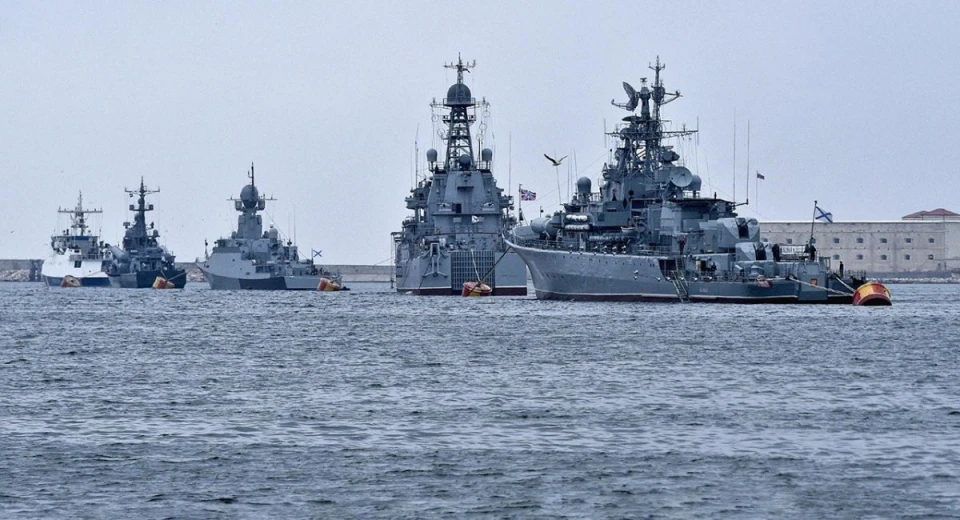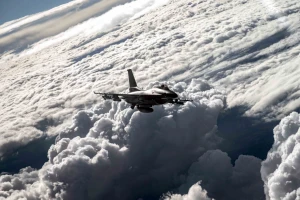
What Ukraine needs to destroy Black Sea Fleet
Espreso explains what Russia's "unsinkable" Black Sea Fleet is today, what Ukraine's frequent attacks on enemy naval targets mean, which were the major strikes, and what it will take to completely destroy Russia's naval presence in the Black Sea
The text delves into the following topics:
- What is the Black Sea Fleet of the Russian Federation?
- What components of the Russian Black Sea Fleet have been destroyed by Ukraine since the beginning of the full-scale invasion and how?
- What does Ukraine need to destroy over fifty ships and boats of the Black Sea Fleet?
- What is the Montreux Convention and what does Turkey have to do with it?
What is the Black Sea Fleet of the Russian Federation?
The Russian Black Sea Fleet is part of the Russian Navy, which is located in the Black Sea. The fleet also enters the Mediterranean Sea. Since 2010, it has been part of the Southern Military District.
The Fleet Command is stationed in the temporarily occupied Sevastopol. Another important naval base is Novorossiysk. Two other points of basing are Feodosia and Donuzlav, both on the territory of the annexed Crimean peninsula.
According to Wikipedia, the Black Sea Fleet comprises 7 military bases (including Tartus in Syria) and is composed of 89 surface ships and submarines. Among these are:
- 14 large ships: 2 large anti-submarine ships, 3 patrol frigates, 2 hovercraft, 7 large amphibious ships;
- 2 diesel submarines (after the special operation of the Ukrainian forces on September 13, 1 submarine was taken out of combat duty and is awaiting write-off);
- 23 small ships and boats: 7 anti-submarine ships, 2 missile ships, 6 missile boats, 8 minesweepers.
The number of personnel of the Black Sea Fleet is 25,000.
According to the 1997 Ukrainian-Russian agreement, the Russian Navy was supposed to withdraw from the Sevastopol base in 2017. However, the Yanukovych-Medvedev agreement extended the Black Sea Fleet's stay in Sevastopol until 2042. Nevertheless, after the invasion of Crimea, Russia unilaterally denounced the basing agreement on March 31, 2014. Since then, the Black Sea Fleet has been part of the Russian occupying forces in Ukraine.
What components of the Russian Black Sea Fleet have been destroyed by Ukraine since the beginning of the full-scale invasion and how?
Since February 24, 2022, Ukrainian forces have destroyed or damaged approximately two dozen Russian ships and boats, as well as one submarine.
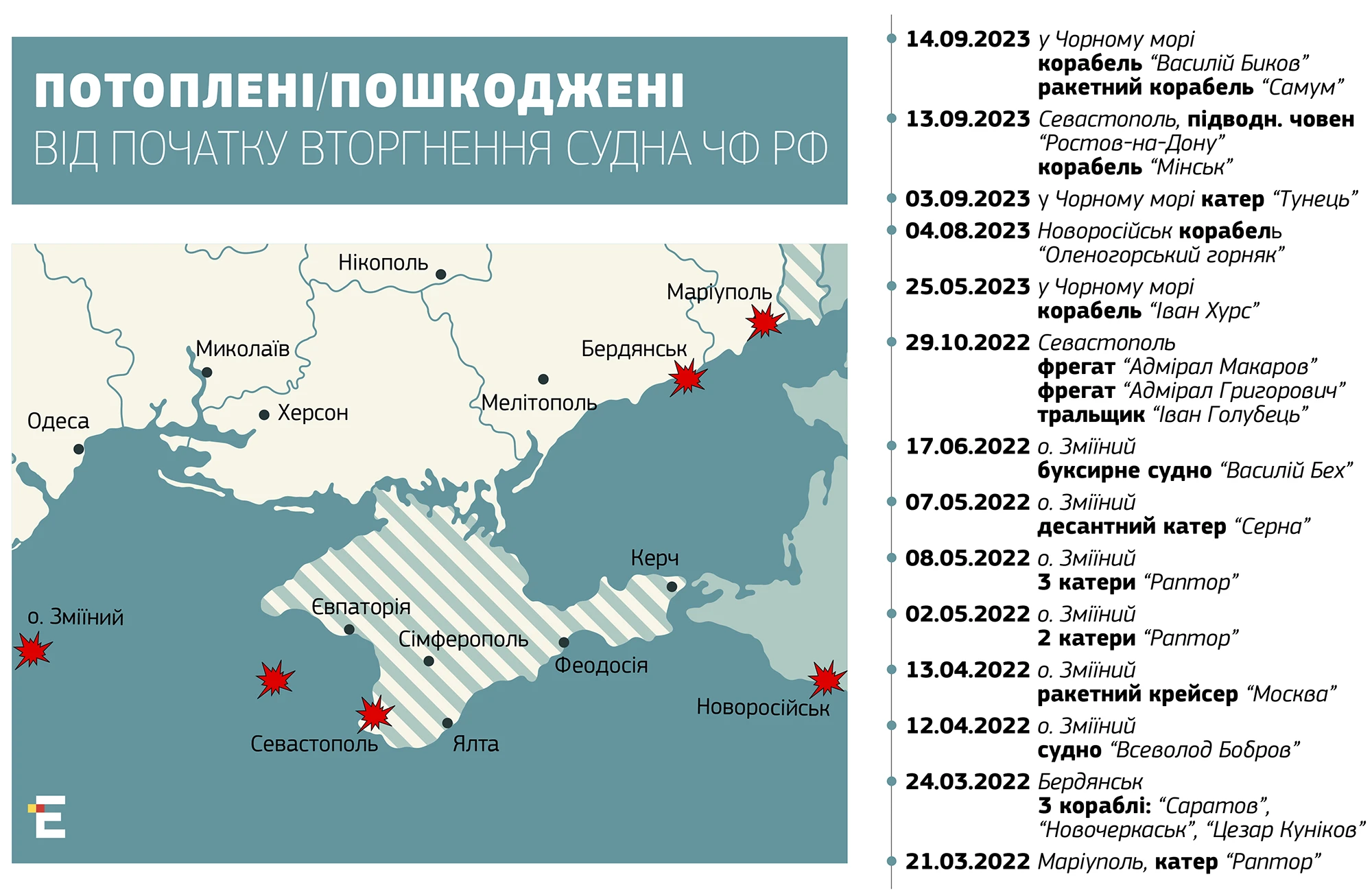
In the first few days of the full-scale war, Russia lost a boat and an unidentified vessel. Later, in March, the Ukrainian military managed to eliminate three unidentified vessels and a Raptor boat in the waters of Mariupol. In addition, on March 24, in the temporarily occupied Berdyansk, Zaporizhzhia region, the Saratov landing ship was destroyed, which had arrived in the port on March 21 to unload equipment and troops. Ukrainian defenders were able to sink the ship with the help of a Tochka-U missile. By the way, Russia recognized its loss only a year later.
In addition to the Saratov, two other large amphibious assault ships, the Caesar Kunikov and the Novocherkassk, were damaged.
Soon after, on April 3, Ukrainians hit a Russian frigate, the Admiral Essen, which was one of the missile launchers that had been firing at Ukrainian cities.
Russia's biggest loss in the Black Sea, and at the same time the largest gain for Ukrainian defenders, was the sinking of the Moskva. The flagship of the Black Sea Fleet, the third largest warship of the Navy, which took part in the attack on Zmiinyi Island, went down on April 14, 2022. The Navy was able to hit the cruiser with domestically produced Neptune missiles. The exact number of the Russian sailors killed is unknown, but the losses could have been in the hundreds. Russia itself officially recognized the deaths of less than 20 crew members.
The sinking of the Moskva cruiser was of military and strategic importance, as it undermined the Kremlin's intention to completely seize southern Ukraine. It also had an effect in the ideological and political context, sharply reducing Russia’s confidence and sense of omnipotence at sea. Subsequently, it helped Ukraine de-occupy Zmiinyi Island and launch a grain deal.
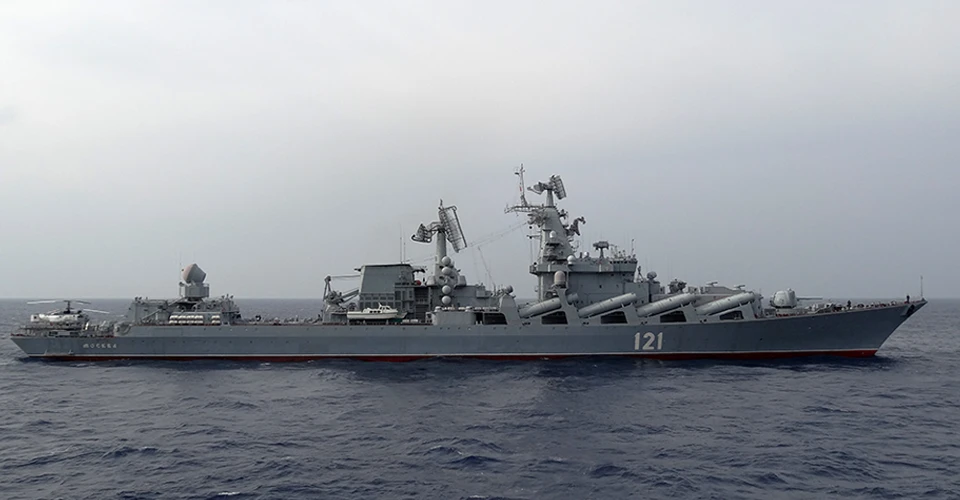
Photo: gettyimages
On May 7, the Russian forces lost a Serna boat that was hit on the Russian-seized Zmiinyi Island by a Bayraktar TB2 attack drone. Less than a week later, on May 12, one of the Black Sea Fleet's newest logistics vessels, the Vsevolod Bobrov, caught fire. Despite the setback, the ship managed to evacuate to Sevastopol.
In addition, in May last year, the Russians lost two Raptor boats in the Black Sea, and two more unidentified vessels.
On June 17, during a "gesture of goodwill," the Russian occupying forces lost the rescue tugboat Vasily Bekh on the way to Zmiinyi. Ukrainian defenders destroyed the ship with a Harpoon missile. In the same month, the Ukrainian Defense Forces mined two high-speed landing boats on the Dnipro-Buh estuary, which the Russians were preparing for sabotage and reconnaissance missions.
Since the beginning of the full-scale invasion, Ukraine's range of striking Russian ships has only increased. On October 29 last year, Ukrainian defenders were able to attack the Sevastopol bay for the first time. The hunt with the help of drones and 'kamikaze' marine drones was quite successful - three Russian vessels were hit at once: the frigates Admiral Grigorovich and Admiral Makarov and the minesweeper Ivan Golubets. Russia used all these vessels during the invasion of Syria as well.
After this successful operation in occupied Crimea, the Russian Defense Ministry reported only minor damage to the minesweeper. It also accused the UK of involvement in the attack on Russian Navy ships in Sevastopol. Also in October, Russia lost another unknown vessel.
The destruction of the Black Sea Fleet by the Ukrainian Defense Forces continued in January of this year. The defenders managed to sink two Russian boats near the island of Bilorudyi and near Kherson.
In the spring, on May 24, Ukrainian naval drones attacked the Ivan Khurs reconnaissance ship in the Black Sea. Russia's Ministry of Defense claimed that the Ukrainian Armed Forces allegedly fired at the ship with three unmanned boats about 140 kilometers from the Bosphorus.
Another successful attack by Ukraine took place on August 4 against the Novorossiysk base in the Krasnodar Krai of the Russian Federation. A large amphibious assault ship, the Olenegorsky Gornyak, was hit. British intelligence reported quite serious damage to the ship, presumably several watertight compartments were breached. Instead, the Kremlin claimed to have repelled an attempted attack on the Novorossiysk naval base.
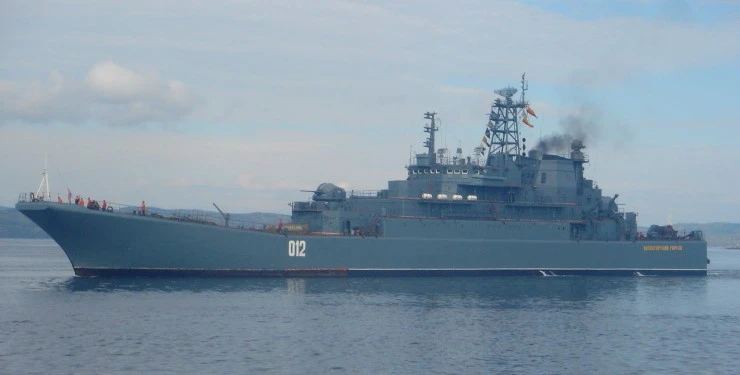
Photo: Wikipedia
It was a joint operation of the Security Service (SBU) and the Ukrainian Navy, the media reported. And Ukrainian intelligence emphasized that the loss of a ship like the Olenegorsky Gornyak weakens the Russian fleet.
The very next day, a Russian oil tanker SIG suffered a drone attack in the Black Sea.
In September, efforts to target the Russian Black Sea Fleet intensified. On September 3, Ukrainian forces successfully neutralized a Russian vessel, the Tunets, in the Black Sea as it attempted to facilitate a Russian landing operation, resulting in the deaths of six Russian soldiers.
Another successful hunt for Russian troops at sea by Ukrainian soldiers was a strike on the Sevastopol shipyard in temporarily occupied Crimea on September 13. Satellite imagery showed that cruise missiles, presumably Storm Shadow, hit the large landing ship Minsk and, more importantly, hit the Varshavianka Rostov-on-Don diesel submarine. It should be noted that an air attack on an enemy submarine is a rare operation in the history of warfare. The Ukrainian Special Forces officers described the details of the operation and the destruction of two Russian vessels.
The Russian Defense Ministry says that the Ordzhonikidze shipyard in Sevastopol was attacked by 10 cruise missiles.
On September 13, the Southern Defense Forces sank a Russian KC-791 Tuna boat in the Black Sea.
The most recent attack in a naval battle so far took place on September 14 - according to media reports, a Ukrainian experimental drone Sea Baby struck a Russian Samum missile ship near the entrance to Sevastopol Bay. As a result, the occupying forces had to tow the damaged vessel away for repairs. At the same time, the Kremlin itself declared the attack "unsuccessful".
For this attack, the SBU used an experimental model of a marine drone that can operate in a storm, hiding from detection behind high waves. Earlier, SBU Head Vasyl Maliuk noted that the production of maritime surface drones, which were successfully used to attack the Crimean bridge in July and Russian ships, was set up in one of the underground production facilities in Ukraine.
It is difficult to say the exact number of Russian vessels sunk and damaged by Ukrainian defenders in the Black Sea, but according to both Ukraine and Russia, the latter lost approximately 20 to 25 ships and boats (the names of large vessels are known, while some of the small ones have not been named).
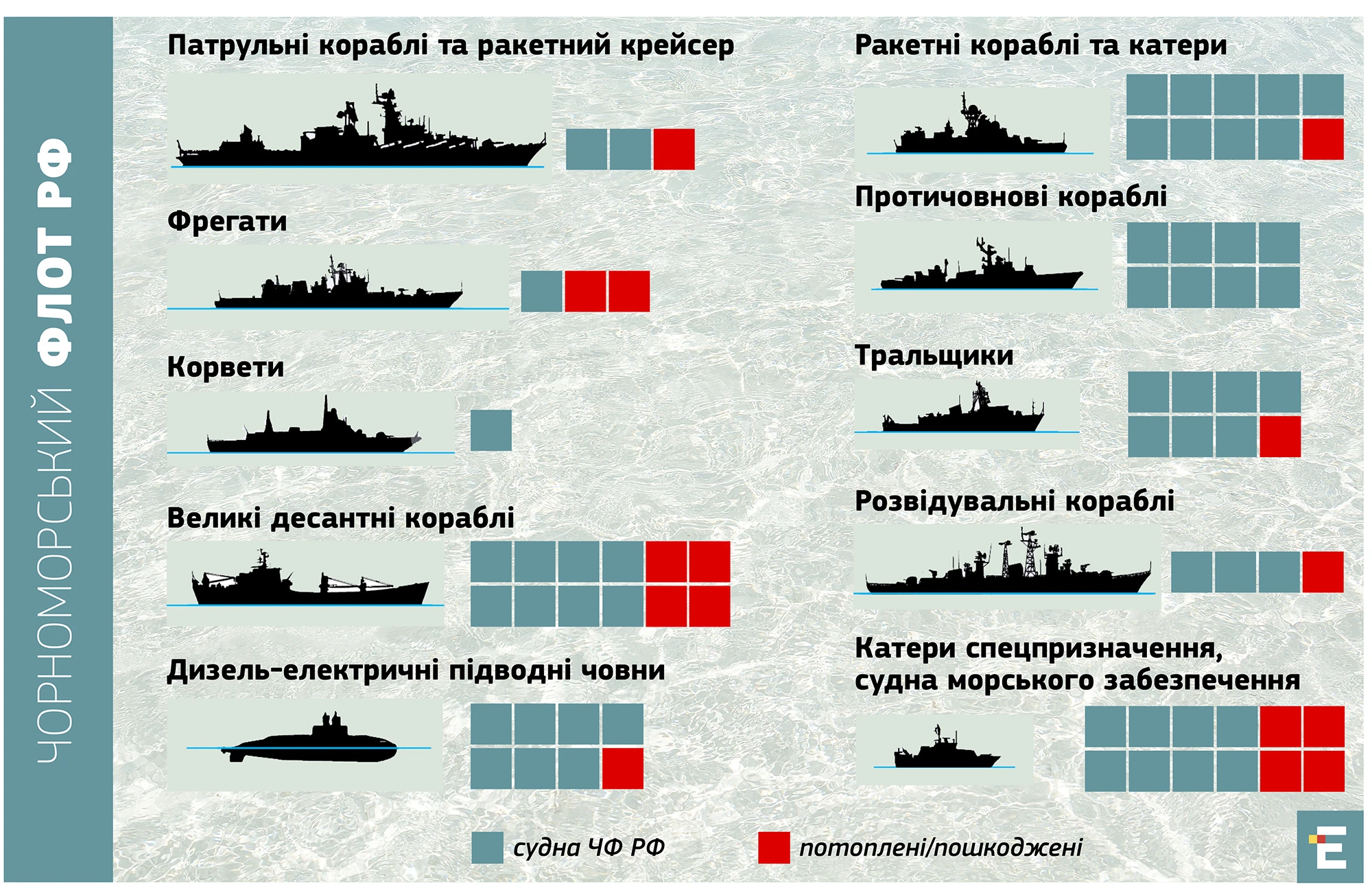
What does Ukraine need to destroy over fifty ships and boats of the Russian Black Sea Fleet?
The latest attacks on Russian vessels in the Black Sea demonstrate the effectiveness of such Ukrainian special operations, so strikes on the main naval bases of the occupiers should continue, said Andriy Ryzhenko, an expert at the Center for Defense Strategies, a first-rate captain in the Ukrainian Navy Reserve. Ukraine should aim at surface ships, which actually pose the greatest threat - they can fire Kalibrs at peaceful cities, land troops or provide cover for their forces from the offensive of Ukrainian troops on the Black Sea direction.
"The strike in Sevastopol was a very well-planned special operation. We need to strike with missiles and drones, in combination. Perhaps, after ATACMS systems are supplied to us, such opportunities will increase. But we need to strike at ports, airfields, their air defense systems, and the accumulation of equipment to weaken this unsinkable potential. To do this, we just need a sufficient number of missiles and drones, competent planning of operations, because as practice shows, the factor of suddenness and non-standardization gives serious success," Andriy Ryzhenko said in a comment to Espreso.
According to the expert, several types of missiles should be used for such strikes. In particular, Ukrainian Neptunes and Harpoons can be used as coastal systems, and their production can be increased. He notes the positive aspect that the domestic Neptune missile is designed to fire at targets on the coast.
At the same time, for sea-based missiles, Andriy Ryzhenko would choose the Norwegian-American NST missile. It is twice as light as the Harpoon - 410 kg - and is very smart when aimed and difficult to intercept. This missile also has a warhead that can destroy, for example, a frigate. By the way, the NST is 8 times smaller than the Termit missiles that were in service with the Ukrainian Navy until 2014.
However, when considering the number of missiles and drones required to neutralize the Black Sea Fleet, which comprises over fifty ships and boats, the discussion would likely involve hundreds of units.
"I would say that hundreds of cruise missiles and naval drones are needed to destroy the Russian fleet in the Black Sea. In fact, no one can say the exact number, not even those who know classified information.
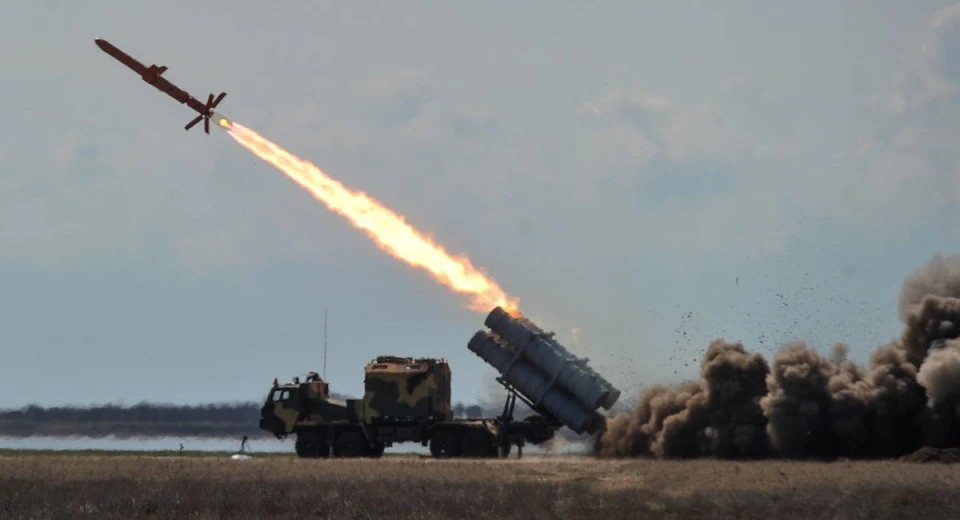
Photo: defence-ua.com
It takes two missiles to destroy a large landing craft. For a corvette, 1-2, and for a frigate, probably 3-4. If someone had asked me about the Moskva cruiser, I would have said that it would have taken 6-8 Neptune missiles, but it was destroyed with only two. Many factors influence this," the expert believes.
It is important to remember that what is taken under control must be maintained, whether it is an island, a spit, or a section of sea. To do this, Ukraine needs a surface fleet. And now the best solution may be surface ships that will guard ports and prevent enemy missile ships from reaching the borders of strikes on Ukraine's territorial sea and maritime economic zone.
Andriy Ryzhenko explains that he is referring to boats that are 20-50 meters long and capable of carrying missile weapons and carrying out raids and attacks on the coast and islands. Without them, it will be difficult for Ukrainian defenders to regain control of the Black Sea in the northwestern part, and especially in the Sea of Azov.
"We have Iron boats, and they need to be rearmed, equipped with artillery and short-range missile systems. As patrol boats, they are quite good, they can carry out mine action. Secondly, we had a plan to supply Ukraine with American Mark VI boats - they would be very, very useful for such operations as the liberation of the Boyko towers, the landing on Cape Tarkhankut, and the liberation of the Danube Delta islands. These boats are very powerful, fast, they have 30 mm artillery, they have short-range missile systems, but this is enough to help marines land and perform the necessary functions. We need missile boats so that we can go out to sea and fire missiles at the enemy where they are hiding," explains the expert of the Center for Defense Strategies.
There are questions about how to deliver such boats to Ukraine without using the Bosphorus Strait. Andriy Ryzhenko says that they can be exported by other means, and the deployment of these vessels does not require the construction of new naval bases.
"It would be possible to deploy small boats like this, even 25-30 meters long. Or perhaps even make them unmanned, so that, for example, they carry a missile and launch it at the enemy at a certain point. If we get F-16s, they can also launch Harpoon missiles, and definitely NST missiles. Again, it is important that we can launch these missiles from the shore, from the air and from the sea. Only in such a combination can we achieve success, as evidenced by the latest strikes," added Ryzhenko.
After the attacks by marine drones and damage to ships, the Russian fleet in the Black Sea is trying to stay as far away from its base in Sevastopol in occupied Crimea as possible, that is, closer to its shores in the northeastern part, the Ukrainian Navy said.
The Defense Forces added that on September 16, Russia deployed its naval grouping in the Black Sea in an interesting way. In particular, they moved four large landing ships to the Sea of Azov, leaving 13 units in the Black Sea.
What is the Montreux Convention and what does Turkey have to do with it?
A few days after the full-scale invasion of Ukraine by Russian troops, on February 28, 2022, Turkey closed the Bosphorus and the Dardanelles. The state, which, according to the Montreux Convention, actually and legally controls the Black Sea straits, used Article 19 of this international document. It directly regulates the regime of navigation in the Black Sea straits and indirectly regulates military navigation in the Black Sea. Thus, it stipulates that in times of war, when Turkey is not belligerent, warships of the warring parties cannot pass through the straits.
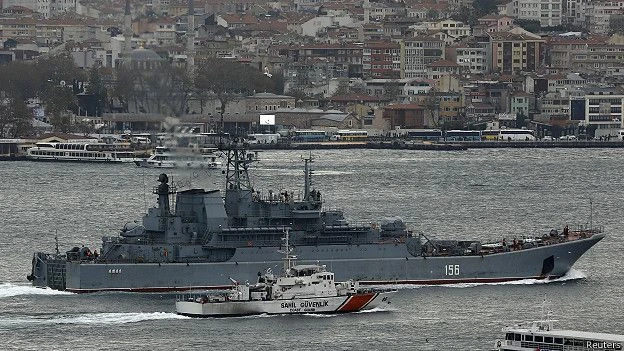
Photo: Reuters
Experts stated that Ankara's decision was a definite advantage for Ukraine. They also noted that Turkey could have applied the Montreux Convention earlier, after the annexation of Crimea and the war in Donbas in 2014.
Recently, Andriy Ryzhenko, a captain in the Ukrainian Navy Reserve and a strategic expert at Sonata, suggested that NATO and Turkey could conclude an agreement on a peacekeeping convoy operation to ensure the safety of navigation in the Black Sea.
At the same time, diplomat Roman Bezsmertnyi believes that Ukrainian diplomacy should return to considering the implementation of the Montreux Convention within the framework of the Peace Forum or convene a separate meeting on the implementation of this convention. He explained that the guarantors of the implementation of this convention are the United Kingdom, France, and Italy, which have repeatedly organized a naval squadron and become guarantors of security in the region when similar issues have arisen in history.
By the way, it was also reported recently that Turkey has postponed the construction of the Russian gas hub, which it plans to use to replace lost sales to Europe, due to alleged management problems. Media reports say that Moscow and Ankara have disagreements over who will own and manage this gas hub. Earlier in September, at a meeting with Turkish President Tayyip Erdogan, Putin said that Gazprom had handed over a roadmap for the hub to Turkish energy company Botas.
Russia is positioning the gas hub in Turkey as a way to change the route of its fuel exports amid a sharp decline in purchases by European countries, hoping to sell some gas through Turkey to those countries that do not want to buy from it directly. It should be noted that Moscow is currently supplying gas to Turkey through the Blue Stream and Turkish Stream pipelines across the Black Sea. As for the latter, the fuel is then exported to Southern and Eastern Europe, including Hungary, Greece, Bosnia and Herzegovina, Romania, and Serbia.
- News





